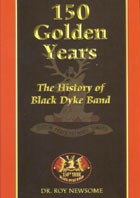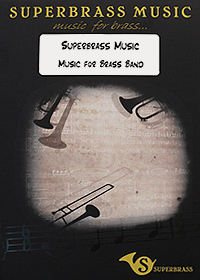Book Review - 150 Golden Years
21-Oct-2005The History of Black Dyke Band
Dr. Roy Newsome
World of Brass Publishing: 231 pages

Written to coincide with the 150th anniversary of the Black Dyke Band in 2005, Dr. Roy Newsome has provided the brass band movement with a true labour of love.
That of course would be the least we could have expected from a musician so entwined with the famous Queensbury outfit, and as such it is a wonderful biographical account of the history of the most famous brass band in the world.
Like all biographies however, and especially those written by someone who has been so close to the subject matter, it is what it doesn't say as well as what it does that also makes it so fascinating. Someone once wrote that all biographies are like bikinis – they are there to both reveal and conceal, and although this one is a makes the most of the Black Dyke figure, it doesn't quite go far enough to make for quite startling revelations.
Dr. Newsome writes with a practiced academic ease that allows the history of the Black Dyke (or originally Dike) Band to unfold in its clear historical lineage. It is not an anthology however as there is no collection here of extended anecdotal perspective; rather it is a well set out, sometimes dry factual account of the development of the band from its beginnings to the present day.
The twelve chapters, which are prefaced by a quite excellent introduction by Geoff Whiteley take the form of appreciations of musical era in the bands history rather than just periods of time. This allows the author to give a fuller account of the people who moulded the band into its pre-eminent position from the likes of Phineas Bower and his amazing family connection, through the imposing and stentorian legend of Arthur O. Pearce, the post war years of social and musical change, right through to the modern day and the period when Dr. Newsome himself made his contributions to the band and its legendary reputation working with the likes of Geoffrey Brand and Peter Parkes.
The amount of work that must have gone into the book has been immense, but you feel sure that there must have been just as much material that could have been included to have made this book twice its length and not lost any of its interest.
It is the early years that for this reader were the most fascinating, with Geoff Whiteley's superb introduction providing an essential foundation stone from which everything else develops. It is these first chapters that provide the reader with the sense of history that so makes this band stand out from any other. The names, the figures, the prize money won, the great players, the even greater conductors and above all, the quite magnificent sense of purpose and determination in making the band the best in the world seep through the pages.
The photographs too are absolute gems, especially in relation to ones from the modern era that unfortunately in the book are not all of the best quality or accurately titled.
The story unfolds with all the highs and lows (as well as tragedies) marked by the author to ensure that small yet significant detail is not lost. The addition of historical footnotes at the bottom of pages is most welcome and allows the reader to digress at points without the text losing its focus. In today's age when there is now media coverage from the internet to weekly, monthly and quarterly magazines it is fascinating to read of the various publications of the pre First World War era and the way in which they reported the banding scene of the day.
Anonymity coupled with a Victorian sense of duty and desire to appear above (and not encourage) mere idle speculation is not such an outdated concept as it seems.
Up to the Second World War the book most effectively defines the legend that Black Dyke becomes. The number of people who were influenced by the likes of Arthur O. Pearce are now less and less, but Geoffrey Whitham was one and his immense contribution to the Dyke story is lovingly retold. To here, the author captures the essence of Black Dyke.
The book though is less successful in its final chapters – from Peter Parkes onwards. Perhaps there are still too many raw nerves and characters still influential in the banding movement for it be any other way, but the story of Black Dyke from this period seems to be slightly sanitized by Dr. Newsome. He is such a respected figure that perhaps he felt it unfair to open too many old wounds over the more turbulent periods and episodes that have occurred in and around the Queensbury bandroom. The wins and the glory are there, but not so much of the ill feeling, the sackings and the times when not all was great and good. Even legends have feet of clay and the foibles of the less than immortal, and all enhance rather than detract from the riveting story that is the history of Black Dyke.
The David King interregnum is rather seen as a period that didn't quite work, but although the reasons are alluded to, it is all a rather smoke and mirror account of the period, and we are left with little additional knowledge to why he left, or why he was thought to have been the ideal appointment in the first place. This too is true of the immensely significant period under James Watson.
There is so much to admire about this book that it would appear to be churlish to highlight its weaknesses, but just like a Black Dyke contest performance, the band has set itself such high standards that they need to be addressed.
There is for instance no appendix to list the wins at the major contests, or their conductors, yet there is a fabulous list of former players in the principal positions of the band right back to its first years. The need for a new proof read for subsequent reprintings (we are sure the demand will cause it to be deservedly reprinted) is also evident – there are far too many annoying typographical errors that detract the interested reader, and the quality of some of the later photographs needs to be looked at again.
As the amorial bearings granted in 1857 to John Foster state: ‘Justum Perfictio Nihil Timeto' – ‘Act justly and fear nothing'. Dr. Newsome has certainly done the former and possibly just missed out on the latter with his splendid book on the Black Dyke Band. It remains though a most enjoyable and essential read for any brass band lover, let alone any Pondasher.
Iwan Fox.









